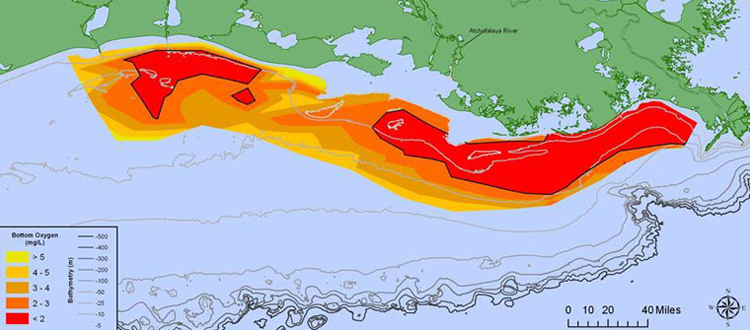A recently released white paper assesses the status of several empirical and deterministic models capable of characterizing Gulf hypoxia, also known as the Gulf dead zone. ‘ Modeling Approaches for Scenario Forecasts for Gulf of Mexico Hypoxia ‘ presents conclusions from the 2013 joint NOAA and Northern Gulf Institute Forum for the Gulf of Mexico Research and Coordination and Advancement. Based on presentations and forum discussions from this panel, the paper concludes that several empirically based models are ready for transition to operational use in scenario forecasts of nutrient reduction goals required for hypoxia mitigation.

The Gulf Hypoxic Zone Modeling Technical Review Panel assessed several scenario forecast models based on their ability to address key management questions, their infrastructure, observational and remaining research needs, and their state of development. The overarching goal was to provide perspectives to NOAA for the next steps in operationalizing hypoxia modeling in the Gulf in support of management efforts to mitigate the hypoxic zone. The Panel concluded that several empirically-based models (models based on observed relationships between experimental or observed data) are ready for transition to operational use in scenario forecasts of nutrient reduction goals required for hypoxia mitigation. However, deterministic models (generally more complex models based on mechanistic relationships between physical, biological, and/or chemical processes of an ecosystem), despite recent advancements, are not ready for use in an operational management environment for scenario-based hypoxia forecasts.
The Panel emphasized continued refinement of the deterministic modeling efforts. The ultimate goal is developing an ensemble (multiple) modeling approach (combining empirical and deterministic models) to inform managers of required nutrient reduction goals, both in the short term and under longer climate change scenarios.
Scenario forecast models provide decision makers with the ability to examine the effect of multiple management scenarios. For coastal hypoxia, this often involves examining the relative influences of climatological (e.g., winds, currents, salinity) and land-based (e.g., nutrient and freshwater inputs) factors on the formation and maintenance of coastal hypoxia.
For more information, contact Alan.Lewitus@noaa.gov.
